-
Posts
270 -
Joined
-
Last visited
Content Type
Profiles
Forums
Store
Help Articles
Posts posted by Baron d'Apcher
-
-
For those with experience using nitrite in pâtés, what percent of the meat portion is required to maintain a nice pink hue?
.25% nitrite of meat weight.
Easter Pâté Pantin, special Greek Orthodox edition.
Game hen, duck, pork, chicken livers, lardo and pistachios. Should be rewarded with orchestra seats to the rapture.
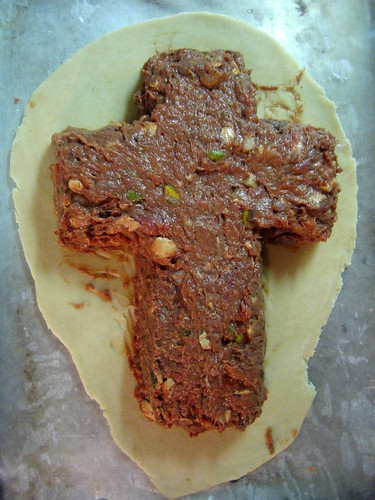


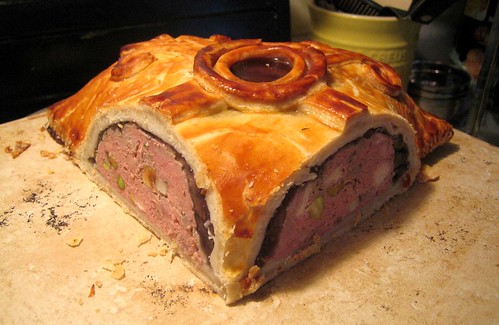
-
This is a very desperate and pathetic attempt to retain control (Communist style) of what is known as an iconic cuisine of the world. Hopefully the Italian Government will realize the error of their ways before it’s too late or else the world of cuisine will leave your country back in the dark ages at the expense of your great Chefs and the enjoyment of the consumer.
Indeed. They have overlooked a couple facts.
1. Nitrates are naturally found (in very high concentrations) in celery, beets, spinach, radishes and cabbages.
2. Italy is shaped like a boot because they couldn’t fit all that crap into a sneaker.
-
An edible monument to Washington, DC’s 5 cent bag tax (which has reduced bag consumption by 87%) and the achingly inane whines against it that are being ranked on water coolers in any progressive office where tolerance, paychecks and science fundamentals have evolved since the 1860’s.
5 scented suckling ham in aspic with ink truffle découpage.

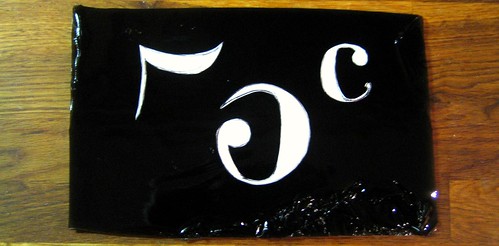


-
In honor of Armistice day 2007, a suitable accompaniment for the RMS Wellington Lusitania was German U-Boat potato salad. Gassy mustard not pictured.
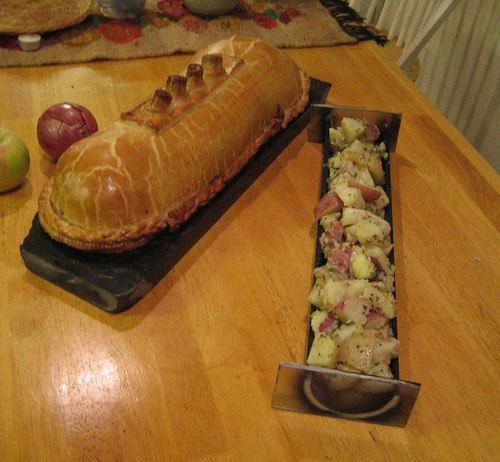
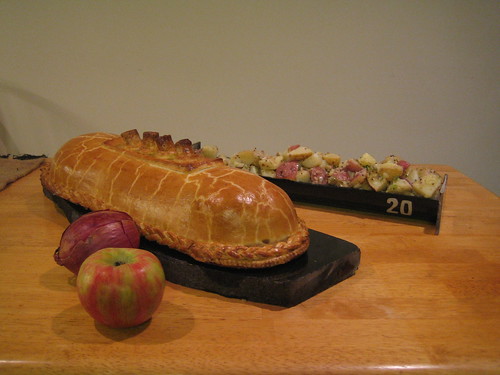
Starboard view
-
 1
1
-
-
"blood orange hollandaise."
Sauce maltaise.
-
Those techniques and equipment definitely have their merits, particularly in a small kitchen with limited eyes and hands to oversee everything, but with a 4-5 person service line-up I'd be hesitant to pay someone to watch duck breasts cook in a water bath. I'm content to use the electric motors in a kitchen-aid or ice-cream machine since it is little more than a mechanized version of the same movement (be it water, horse or electrically powered), but that whole discussion has exhausted me.
However, I'd like to offer Mr. Melonas a triumphant piece of video chocolate to confirm and celebrate the accusations of chefs using techniques that they have not developed and not clearly attributing credit. Consider Michael Voltaggio's "aerated brioche", pretty much copied verbatim from Albert Adrià's microwave cakes. While Mr. Voltaggio does not claim that the technique is his own, he ambiguously uses "I", does not credit Mr. Adrià, and given Michael's recent televised celebrity (and culinary validation?) it is possible that viewers/"fans" would assume the techniques to be his own, and that's not right. At the very least he could have provided a link or credit to Albert on his website. A forthcoming recipe has not yet been added.
Michael Voltaggio's "aerated brioche" demonstrated by Michael Voltaggio
-
Sea Bream "Belle Vue"
Stuffed with shrimp, my lardo and citrus.
Shingled with carrots and beef knuckle aspic.
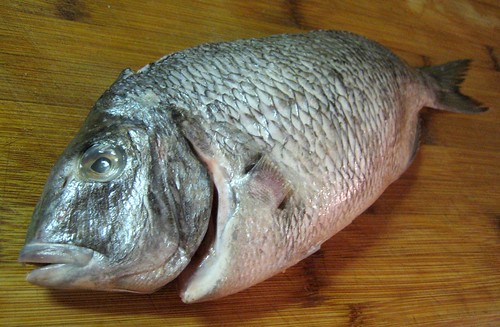
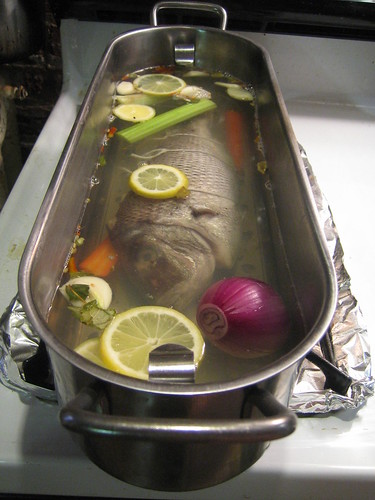
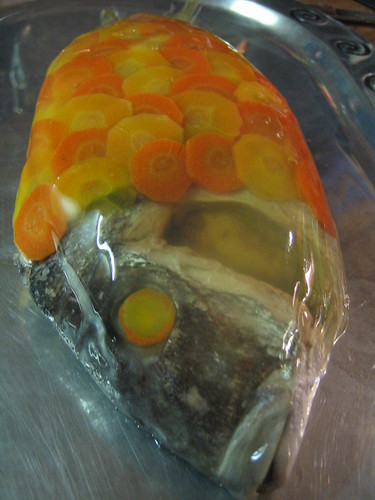
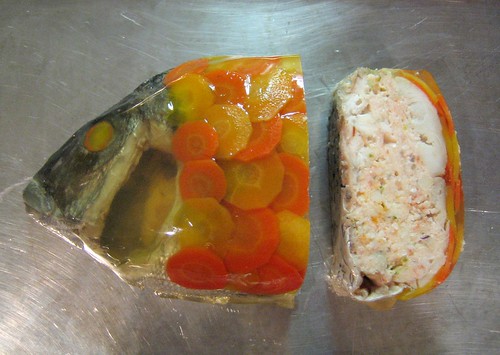
-
Thank you for the evasive response reminiscent of a US Senate hearing and congratulations on being the progenitor of food presentations based on a Rubik’s cube. Clearly whoever designed the novelty cubewich is a faithful (though unethical) reader of Madrid Lab because no one else would independently think of making a cheeky sandwich based on an iconic toy that has been around for 30 years and sold over 350,000,000 copies.
I do what I do and I do it how I do it because I can almost Guarantee with 100% certainty that it will be the same every time!...Doing what we are now doing with food gives you another option to the Vending machine if you want close to perfect food every time!
You do not serve guests at the Madrid Lab so your ability to experiment with top of the line equipment without food cost or interference is a luxury that only a handful of chefs will ever know. Ideally everything should indeed be perfect, but that is not a reality for many restaurateurs who work in cities or towns that have not been lauded by Michelin, are not capable of charging premium prices based on their neighborhood or economy, don’t require a brigade and can not be sustained by reservation-only seating. What is de rigueur for elite restaurants is not the case for others whose payroll can not afford captains, proper equipment and their rent isn’t paid for by the hotel. Perfection is extremely difficult and accordingly rewarded. The course of pursuing such perfection will likely be tested by errors –a long ticket time, dropped plate, guest went to smoke a cigarette…or that one overcooked fish which has to go out so that the meals of 30 other guest aren’t jeopardized.
Most of those problems can be avoided in well budgeted sterile environments where nothing can go wrong and guests pay what I earn in a week, but they are not accessible to most and do not fill the need for guests that are dining for the pleasure of dining rather than expecting a life changing experience.
I measure recipes by gram units, use thermometers, timers and strive for consistency as does any disciplined cook, but the gadgetry and Cartesian approach of delineated ingredients is not within the reach of most cooks. Molecular gastronomy (or whatever you want to call it) appeals to few people and therefore is not a viable style for most chefs to adopt. Your standards are reasonable and the progressive theory/practice is sound, but it requires much training to do well (lest they be the focus of your scorn –for doing it in the first place too) and working chefs are not immune to the occasional hiccup.
-
I have never had a problem with people using existing techniques as everyone cannot create new techniques for every dish in their menu, but I think it is important to acknowledge the creator instead of claiming it as one of your own.
There is a curious flavor of hypocrisy, pretzel logic and distortion of “technique” in your ethos/edict. In your first post you decry the copying of techniques under the assumption of celebrity aspirations, (though your celebrity is defined by those techniques) and neutered conceptual theory, affirm that food should never be a magic show (many of your preparations suggest sleight of hand “how’d he do that” techniques to general admission diners), then later assert that you neither copy nor are inspired from books. A few queries:
1. Must a chef acknowledge who invented the particular technique for clarification and spherification when serving consommé caviar? To who and where?
2. What is the statute of limitations for distinguishing new from existing or old techniques?
3. Which chefs falsely claim to have invented a technique that they are using?
4. Who do you credit for creating techniques that you use, eg: transglutaminase to fuse items in your Rubik’s cube (another non-threatening coincidence) or sous-vide and TG for your signature dish (both of which were developed in the 1960-70’s by the industrial food processing industry for the former and 3M’s Scotchpak or George Pralus who recommended to the Troisgros Bros that poaching their foie gras in a bag would reduce the weight loss from 40% to 5% for the later)?
As for the marginal beet caviar, it is possible that its humdrum taste/execution was part of a burgeoning repertoire, that the chef had not yet perfected the technique, or that the beet juice simply wasn’t seasoned enough which is not a valid reason to dismiss the chef nor the procedure. Perfection is rarely achieved in one attempt. It demands trials which are necessary in understanding the limits of cookery (time, heat, water, salt, etc…).
Chefs should not stop serving poached fish if on the occasion that a guest has had it, it is overcooked; just as white-knuckle winter sports should not be abolished on account of injuries or death. Few dining experiences will be perfect from soup to nuts since the organic elements differ from day to day –weather conditions, meat marbling, sugar content of vegetables- and as those who have traveled during the holidays or gone out on a weekend night can attest, things don’t always run smoothly when it gets crowded. If anyone wants incontestable consistency on their terms, consider dining from a vending machine.
If chefs do not have the blessing to experiment, progress and fully understand these techniques and presumably serve their beta versions so long as they have dining merit (since they likely have to cover the costs of their food purchases and do not have the luxury of closing for 6 months to test prototypes), how will they be able to determine who is doing it right or wrong, or does that privilege rest only in the stifling hands of the “progressive” molecular monarchy?
I still don't understand how people claiming to only support "classical cookery" are only really talking about techniques and concepts only around for a century or two. Flame on meat is classical to me, and that's still how I like my steak. But hell, if I can cook that steak sousvide to the perfect doneness before throwing it over the flame then I am sure going to do it.
Personally when I go out to eat it is either to get something I can't make myself at home without investing an absurd amount of time creating. So that usually means a tasting menu, I find them enlivening and inspirational.
Unless that plastic bag can be reused it is a liability to the environment for the sake of selfish personal pleasure (gluttony?).
The proud human element of cooking is nudged aside with industrial techniques such as sous-vide and reducing ingredients to mere numbers. A craftsman's worth should be determined on technique (mastery) rather than a technique (method) and the ability for a conscious, thinking body to reproduce as close to the same repeatedly despite varying product, environment, circumstances, whathaveyous. I prefer the charming nuances of hand craft over the sterile, factory uniformity; the same human element that draws us to consistently reliable and unique musical, athletic or theatrical entertainment, hand-blown drinking glasses, hand-made clothing and the satisfaction of building a table from hand-cut lumber instead of assembling one with hex keys and instructions.
I prefer the craftsmanship of a 17 ruby pocket watch over a quartz Casio, even if the rubber wrist-ticker keeps more consistent time and you can jog with it. Necessities, comestible or material, can be distilled down to a matter of taste and an appreciation of origins, labor, history and pride...or at the very least anecdotes that sift out shallow girls at parties if I have the courage to talk to any. Perhaps it is nostalgia for a rumored time when presidents wrote their own speeches, passersby said hello and someone in the room knew how to sew a button. The loss of telegraph manufacturers for humanity is negligible and an inevitable consequence of modernization, but since the proliferation of cellular telephones, who remembers their best friends' numbers today like they did growing up. Buddies & horns will likely exist for the rest of our terrestrial lives but certain fundamental operations are crippled by the more faster and streamlined evolution of what “functions” and “functioning things” require of us.
I do not entirely dismiss vacuum cookery nor fear its immediate pinko proliferation, but feel that traditional methods of fire & steel provide more satisfaction to epicureans than warm -n- plastic, much like driving a standard transmission feels better than an automatic or how hand writing a menu with a Waterman elicits more joy than tickling the qwerty.
-
@ Adam, Agreed. And for what it is worth, MadridLab is a worthwhile read.
However,
... I choose to use these to understand the different styles which different Chefs have so I can see the world through their eyes when I open their books. Never to inspire dishes nor copy anything.I understand the austere pride of self tutelage (though a 3 year Hyatt Hotel Apprentice might qualify as a grounded, recognized period of study. Most chefs or other tradesmen truly learn their trade after the formative years of school), but there is no shame in acknowledging influences and inspiration which offer more credibility to a self-taught pedigree and a more romantic narrative than “I just came up with it in my orgone box”. Airplane rivets inspired the 1933 Bugatti type 59 GP, organic lines in nature inspired Mucha and Art Deco, Auvegnat panoramas inspire Michel Bras and he has inspired the chefs of San Sebastian as well as your friends.
“‘His influence is massive. What he planted seeds for was a culinary revolution,’ asserts David Chang whilst Wiley Dufresne admits, ‘he has been copied by every chef in the world. We’ve all taken a page out of the Bras book – the smear, the spoon drag, putting food on a plate like it fell off a tree.’Bee Movie led you to noodle with honey. That probably counts as inspiration and if those particular dishes were to win awards it would be nice to give a nod to the folks at DreamWorks. I get my inspiration from Gallagher, large breasted women, Languedoc and the collected works of Escoffier and Alexandre Dumas, which I shamelessly endorse and credit despite dropping out of culinary school after 3 months.
The spherifications are likely not a process that you have invented (I think the esteemed Adrià did, in 2003, and then inverse shperification in 2005 by adding calcium chlorate; you’ve probably read his books) and surely your introduction to it as well as sous-vide, methylcellulose, meat glue, agar agar, hydrocolloids, maltodextrine, lactic acid fermentation, gel based pasta, rice & yogurt (Persian Tah-chin or Indian Thaydir sadam) and a slew of other additives/techniques in your repertoire came from someone else’s epicurean work or other, either read, heard or seen. If it suddenly occurred to you one morning while brushing your teeth that you were able to understand the foundations and fundamentals of molecular whathaveyou and copy incorporate the processes into your preparations, well then that is remarkable and you should pitch your story to the folks at DreamWorks.
If the success of “progressive” cookery is dependant on authentic and properly understood techniques then there should be a free flowing exchange of information between its progenitors and patrons. Using freely published material found in print or binary in an effort to understand techniques isn’t really stealing and if the results are satisfying to both chef and guest; no harm no foul…and then there are those who insist on making whatever is on IdeasInFood and you should expose them as creatively impotent frauds if they are a detriment to your style -though I saw urchin ice cream on a menu back in May 2009 and Gray Kunz may have done an urchin custard a decade earlier. Who is copying who? Or perhaps there are simply nuanced coincidence? Dante Boccuzi was serving saffron braised octopus terrine (precursor for the octopop) in 2002 (Art Culinaire #66).
-
I was not aware that the octopus lolipop was to be eaten warm; consequently your technique is appropriate, though were it to be eaten cold it could be fabricated with century old techniques of poaching, clarification and the application of aspic. As for the use of carrageenan extracts as thickening agents, they have been used for centuries (on an industrial scale since the 1930's) and may not qualify as progressive.
What I do not do is try to believe that what I do is the best and tell people they should all be doing as I do…Your original post suggests otherwise, repudiating celebrity starved chefs who allegedly “steal” techniques and do not have their own theory while applauding and validating your own use of said techniques (divinely inspired and learned?) and plugging a dubiously flattering Wikipedia entry in your signature.
...a Chef...who claims to cook “Molecular Gastronomy”, this is the first alarm bell for me as this generally a Chef who only produces copies and cooks to be a celebrity. This is a Chef who cooks with no concept and no theory and he is like a Bower Bird, taking and stealing techniques and entire plates from other Chefs until he has a menu which is made up of nothing but copies (slightly resembling a Shanghai fake good’s market). This is generally the first Chef to change his style and jump on board the next “In” concept and abandon what he has been doing as there is no sentiment anyway due to the fact nothing belongs to him. Just look on the internet and see how many people are reading the latest cook books and reproducing the works of other Chefs in their restaurants, where is the creativity and passion in that?The second group of Chefs are those who are the pioneers of a concept and are active contributers to the long term future of cuisine, These Chefs cook with heart and all of their creations come from within, not from what they see or read.* I like to consider myself as being a part of this group which is populated by many truly amazing Chefs such as: Paul Pairet, Andoni Andruiz, Dani Garcia, Grant Achatz, Ferran and Albert Adria, Alex Atala, Quique Dacosta Wylie Dufresne + many more. Chefs who cook to a Concept and who will never steal for the sake of an easy dish... By purely copying the work of other Chefs there have been many Chefs who have been able to fool media and their diners into thinking that they are performing some kind of intelligent cooking, but instead the truth is that they are like a good parrot being able to see and replicate. I have eaten in many of these places all over the world and each time I am more and more amazed at how little they really understand about what they are doing.
As far as “intelligent” cooking (simple, efficient, consistent) with the use of meat glue is concerned, I prefer to see monkfish tails stuck head to tail to reduce waste, increase yield rather than the confection of a novelty which for me does not represent a dish as much as it does gimmickry. Intelligent cooking is demarcated by producing something flavorful efficiently, successfully, consistently with little waste and occupying as little cookware or space as possible.
While I choose not to use lab flavored theory & practice (with the exceptions of curing salts and the occasional vacuum cookery) I have friends who do study and replicate the works of those in your “pioneering circle” (just as almost everyone at some point has copied/imitated/personalized the style of their admired predecessors –be they cooks, artists, writers, athletes of craftsmen) in an effort to understand and eventually tailor them to their fit and their trials should not be poopooed as fashionable or condemned to bandwagon fallacy.
My ham in aspic or chicken in chaud froid are pure showmanship, as is your octopus lolipop, though my copying of fundamental techniques should not diminish the quality or soul of the dish. Our epicurean philosophies are in different orbits and will likely never cross. I do not feel threatened by your new ideas, nor should you fear the old ones I dig up. I’ve deconstructed plenty of things, but then realized I like my lettuce as it is, not frozen, powdered nor puréed. What I object to is the notion that unknown chefs are not deemed worthy by you of replicating and experimenting with techniques that you have not necessarily invented, but rather adopted for original presentations using well established methods studied by an earlier generation than yours; Mssrs. Kurti, This, McGee, Adrià, Blumenthal, Dufrense, Gagnaire...etc. While you may recognize a chef's use of hydrocolloids and gums or whatever from another book or restaurant, most dining guests will not and budding chefs might not have the resources to experiment in their own time on their dime.
*You will be hard pressed to find any chef worth a damn who does not have a library of books or internet resources that they use for education, reference and inspiration.
-
In my food there is a lot of Technique and many points of humor in a 27 course menu, but it is there because it serves a purpose or helps to tell the story I want to get across. Let’s look at what makes a meal……………….
Overall feeling of satisfaction by the end without being excessively full or under fed.
Highs and lows during the course of the meal
Balance of temperatures
Balance of textures
Nourishment
Enjoyment!
Did you notice that nowhere in that list did you see the need for 8 courses using spherification in the same menu?
That would be a trendy, long winded story of 27 vignettes as opposed to the standard 5 points of Freytag's dramatic pyramid, the dining allegory being hors d'oeuvre->first->main->cheese->dessert/coffee. There is no reason to offer so many courses other than for the sake and distinction of serving so many courses. It highlights a lack of restraint, adderall or spastic composure and without a syllabus/take-home-menu is too much for the diner to retain. Portion sizes in a 27 course meal, though one might be a scented toothpick or belching carrot do not constitute anything more than a 1 bite hors d’oeuvre and can not successfully be paired with libations save for a few drops from a pipette. One notable exception of fierce gluttony would be Jim Harrison’s 37 course lunch at marc Meneau’s L’Espérance, an epic feast worthy of Trimalchio.
I had a 30 course meal at José Andres’ Minibar 6 years ago, a series of morsels; a truffle scented napkin, a mojito spray, deconstructed this and that, conch shooters, cotton candy foie gras and so on. Many of the “courses” (more like the gustatory anthropomorphism of beat poetry or stuttering) were exceptionally flavorful, technically interesting and well balanced. Others –a medium rare lobster medallion skewered on a plastic syringe filled with cool lobster stock is what I think about when I have to vomit during a proper hangover. We were recommended to sip either sparkling wine or water so as not to confuse the palate. It was an enjoyable evening, like going to an auto show and seeing awe(ful) inspiring prototype vehicles that provide a showcase for engineering visions, showmanship, theory and whimsy…though in the end they may not be practical.
A well imagined menu can be offered with 5, even 3 courses, comprised of composed plates that feature a protein, vegetable, fruit, starch or legume with appropriate garnishing elements which fulfill the aforementioned balancing requirements and have themed continuity by virtue of the season, ingredient or tradition. Most get pleasure from being able to savor, explore, understand and contemplate a dish while consuming it and entertaining fellow guests as opposed to what boils down to a formal, seated cocktail party with 27 courses of a single stuffed olive or single slice of cucumber providing the vehicle for faux caviar or whatever.
As for technique vs technical wankery, I posit from experience that there is no need to fuse octopus with Transglutaminase. Octopus has more than enough natural protein and gelatin to fuse itself on its own if poached in a small enough vessel in properly seasoned liquid, then pressed into a form. The signature “octopop” preparation (using transglutaminase) clashes with your delineation of progressive techniques and when/why to practice it. It would make more sense to use the meat glue for a product that is not able to stick on its own rather than over-thinking and complicating a naturally occurring process with “magical”, unnecessary sleight of hand.
Certain techniques and recipes you use and formulate are indeed interesting, but there is no need to hyperventilate from the alleged demise of progressive cuisine. Though there may be 1 less celebrity chef making fried oil bon-bons, there is a slew of unknown disciples and students intent of looking forward in as much as there are engineers keen on making lighter, stronger materials.
Myself, I look backwards for inspiration in an effort to preserve and revive many forgotten, traditional, regional and esoteric elements of French cookery.
Also, in the spirit of tradition, authenticity and purity, after following some of the links on your flattering Wikipedia entry, Bordelaise sauce requires red wine and bone marrow to fall into the spectrum of such an appellation.
-
A Pont Neuf potato is what Americans would consider a rectangular "steak cut" fried potato, namesake of the iconic Parisian bridge. It is blanched and fried like any other French fry variant. Using potato purée as a base for a fried potato representation qualifies as pommes Dauphines and requires roughly 1/3rd choux base to hold it together.
-
This is excellent advice and somebody else mentioned french onion soup prepared a day before. I think most of the flavor in the soup comes from the carmelized onions and I think we could use bouillon cubes or a stock base to help it. It should cost next to nothing as I can get 3 lbs of onion for 1.69.
I’ve made 5 gallon batches (6oz x 100) of French onion soup and it required a 50lb bag of onions, along with a tilt-skillet (for cooking surface area) to cook them. Onions are mostly water and after caramelizing they reduce by far more than half.
If you are trying to make a silk purse from burlap, look for inexpensive ingredients that expand and thicken upon cooking, rather than reducing and throwing water. Barley, beans or lentils will double in volume and thicken a soup base as well as being appropriate for winter. Furthermore, 5 oz of such a soup will be more filling that 5 oz of bouillon cubes or stock base which will offer more salted water than flavor and absolutely no viscosity. A few calves/pigs feet, raw pork belly with skin or some chicken legs will indeed give the stock more body; the chicken leg meat can be picked and thrown back into the soup.
-
I am one of those expect the worst and hope for the best personalities...but I think you will end up spending far more to feed 100 people. The prep list seems to lean dangerously close to the side of shortage. Based on the spreadsheet it might be difficult to make 100 crostini with that amount of tapenade (less than half an ounce per crostini?) or feed 100 with 4 lbs of salad. The price of the olive oil does not appear to be factored in.
If it is not too late, consider making a soup which will be more consistent and easier to serve; perhaps a root vegetable soup with water, aromatics and such puréed. Root vegetables are cheap and will thicken the soup nicely once cooked in butter with onions and some herbs, couple slices of bacon and so on. I'd ditch the stew and get 2 whole sirloins cut into thirds lengthwise and grill them instead, then cut slices and serve veg on the side and make an herb butter or something. Bourgignon is a waste of wine on your budget and you'll need significant kitchenware (rondeau or hotel pan) to do it properly.
Perhaps save the wine from the pears for your guests to drink and poach them in spiced syrup (sugar, water, cinnamon, clove, allspice...etc) and serve half a pear with a small scoop of decent quality ice cream.
In my estimation and experience, college kids would rather drink wine than eat it.
-
Consider "Culinary Artistry".
It is an alphabetical directory of food items (proteins, veg, herbs, spices, regional themes) and below them is a list of their generally accepted methods of cookery, accompaniments and season. Chicken will have various methods of cookery and a significant list of appropriate garnishes, though it will be up to you to decide how to cook them. For what it is worth, "chicken sauté" is ambiguous. Perhaps redefine your main protein and it will be easier to search for a suitable garnish, though such a list would number in the thousands. It would be preferable to limit such a list by cooking with the seasons.
-
The eyes will invariable pop out a bit. I usually provide my pigs with some sort of sun-screen in the form of greased tin foil over the ears and snout to prevent burning.
"Suckling Porchetta Richelieu"
With pears, pearl onions, turnips and an inlay of sausage made from their greens.
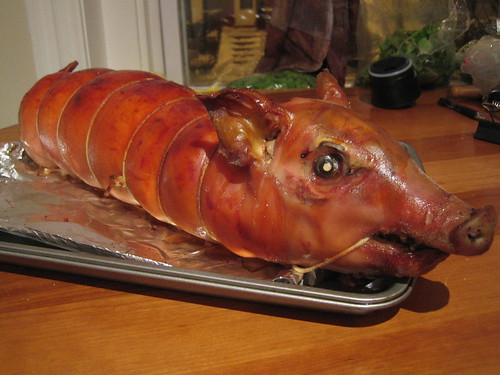
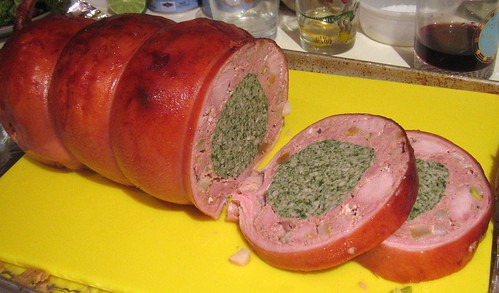

-
Use russets as they have a higher starch content and will stick. Don't soak or wash away their starch. Yukons have less starch, more sugar and therefore will not stick and are likely to burn.
-
How big were they prior to stuffing? And how old?
The star fruit porchetta seems more pink than the others. Any particular reason?
The first 2 piglets were Amish raised from Pennsylvania; 15-17lbs and maybe 4-5 weeks old?
The last ones were black footed piglets closer to 20-22lbs from Bev Eggleston at Eco-Friendly Foods.

The top porchetta overcooked in the oven for my liking while I was getting juiced on rum drinks poolside and the color preserving qualities of that particular selrose were not worth a damn. The special starfruit edition had nitrite (.25%) in the forcemeat to maintain a more congenial, rosy color and was very slowly roasted, lowered closer to the coals after an hour once the mechanism was deemed sort of functional. The forcemeat contained 1/3 panade (breadcrumb, puréed liver, fatback and meat) which offered a smoother texture.
The last two were colored much like the first, though without any seasoning other than salt, pepper, garlic and herbs.
-
Consider deboning the pig and making a forcemeat with the scraps and offal with which to stuff the pig. More of a ballotine but still in the realm of porchetta. Here are three methods of cookery. Tie or sew it up and apply heat in the form of oven, coals or grill.
Pennsylvania raised pig was stuffed with scraps, diced offal, pickled apples, pistachios, dried bing cherries and roasted in an oven. The loins were kept attached. Ears and snout were covered in foil to keep them from burning and the skin was basted with oil and vinegar to get it nice & cripsy.
Still life porchetta, with pickles and punch
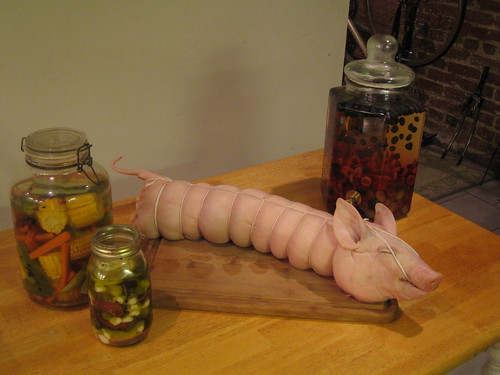

Not my Redbull
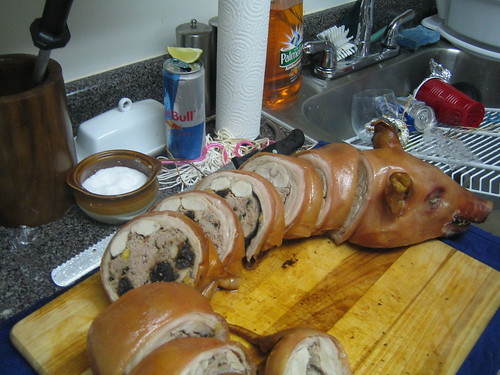
Porcine Pedaler (beta version). $5 Home Despot amalgamation of cycling, BBQ, Free Market economic theory, Protestant work ethic and the ballad of John Henry.
Meat: 16# suckling pig. Deboned, stuffed with starfruit, cashews and tropical spices (nutmeg, mace, allspice and clove). Basted with fresh coconut water and olive oil. Served with cashew and tamarind satay sauce.
Metal: 52cm hand-polished aluminum Raleigh fixed-gear conversion BBQ spit. 41 x 200± gearing for a 0.4 ratio. 8' chain catching the spoke nipples of a road wheel fixed to a threaded 5/16" spit rod placed on 700c forks. Chrome BMX chainring counter-weight and floating road chainring to give the drunks something to marvel at and a piece of gate to help straiten spit which bent under weight of the creature. A very rustic soup-to-nuts Sunday afternoon build and not OSHA sanctioned. PP 2.0 will have a welded frame to contain the torque and weight of drive-train as well as an integrated container for the heat source.
“Anything worth consuming is worth sweating for; bourgeois electric spits be damned.”
Max Weber, 1907

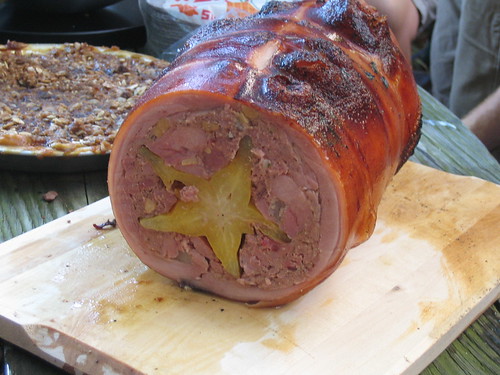
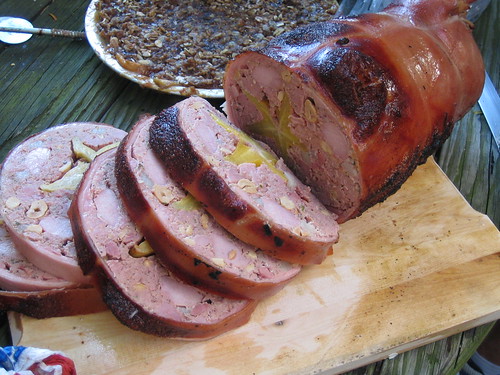
These traditional porchettas (not mine) were merely stuffed with garlic, fennel seed and rosemary, then grilled.
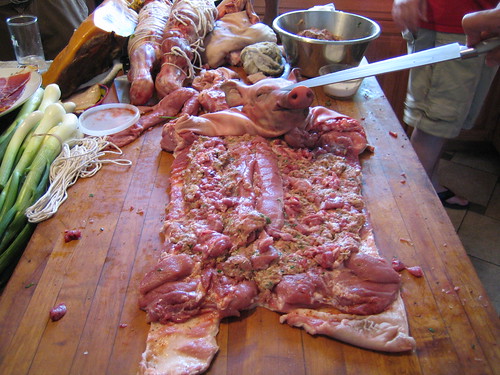
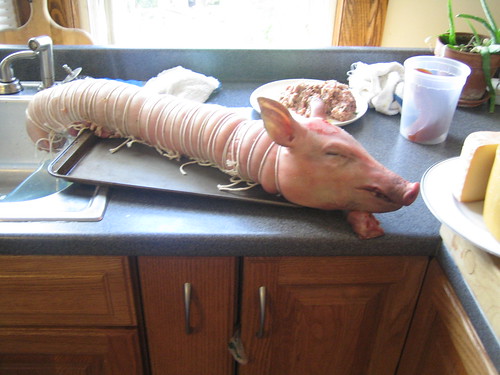
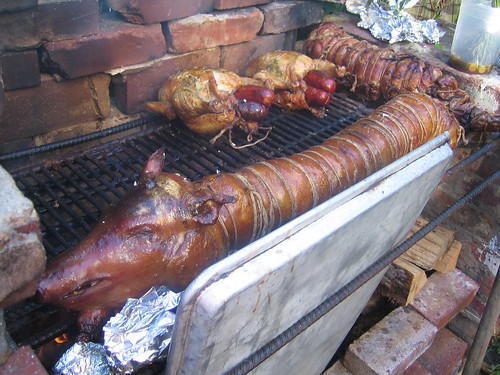
-
Consider working with the seasonal and traditional accompaniments as per Le Repertoire de la Cuisine; root vegetable glazed in appropriate fat (butter, lard or oil depending on the region or protein) with salt, a little sugar (to replace natural sugars lost and to maintain the vegetables’ cell structure) and finish with vinegar for acidity, to preserve color and stop the cooking process. Blanched vegetables and/or beans in warmer months and heated through to serve in the aforementioned regional fats.
For classical French adornment, practice knife cuts such as turned potatoes, crescent carved turnips or rutabagas, beveled carrots/parsnips and
(naturally) for showmanship and discipline. Use trimmings for aromatic garnishes when braising/simmering meats and whatever.
-
The aspic was poured in through the chimneys once the pâté had cooled. Poultry pâté got the poultry aspic treatment whereas the predominant pork versions got the porcine equivalent; in both cases the respective consommé was colored with red wine and thickened with gelatin. Initial prototypes were met with modest almost disastrous results until proper dough, forcemeat and aspic recipes/proportions were determined. Anything worth screwing up twice is worth screwing up thrice and it remains a crucial exercise in learning cookery limits (heat, fat, salt, water, time, method)Nicely done. Did the aspic layer just ooze out, or did you pour that in through the portholes?Pâté pantin Richelieu. Beta version.
Pâté fail. Pastry fell apart, aspic too loose, forcemeat dry.
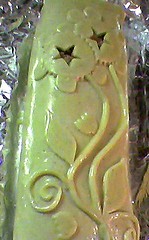
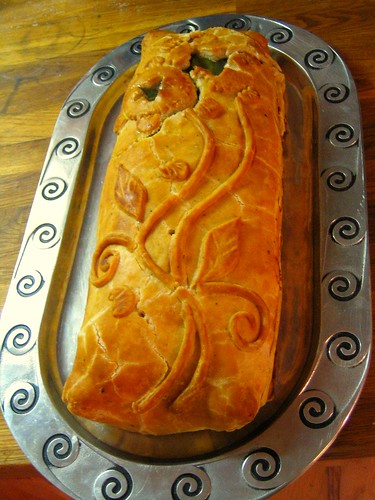
Pâté pantin 2.0. Special poultry edition.
Better. With poached chicken, gizzards, liver, carrot and celery.

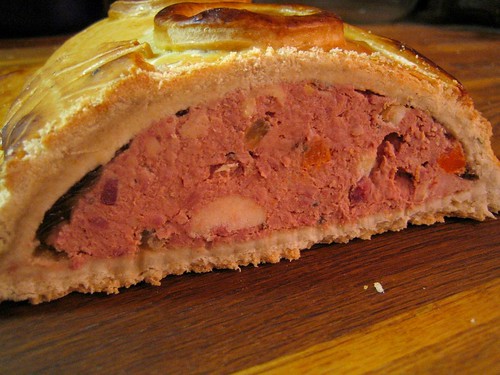
Turkey Pâté pantin 4.0. Special Thanksgiving edition.
Well executed save for hasty pouring of the aspic. Turkey, pork, duck, poultry livers, gizzards, pistachios, currants and fatback.
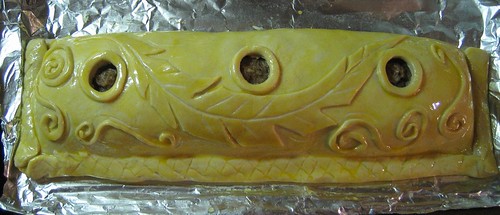

-
Pâté Pantin.
Pork, chicken, chicken livers, confit gizzards, fatback, dried cherries and pistachios.
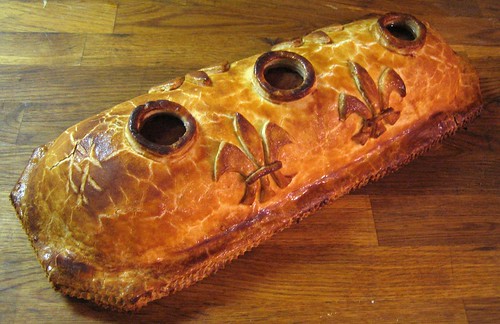

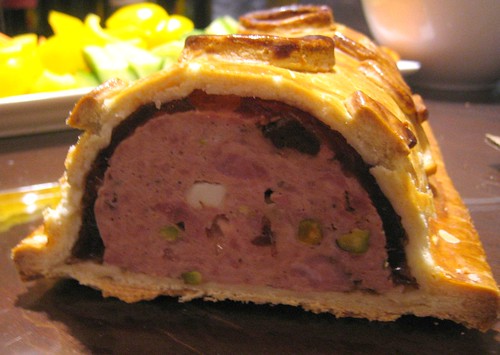
Excess pastry and forcemeat was destined to diminutive pâtés en croûte.
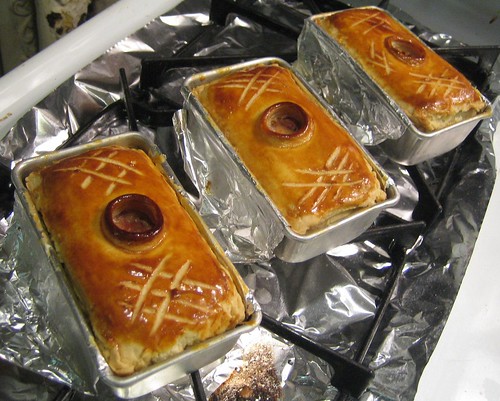
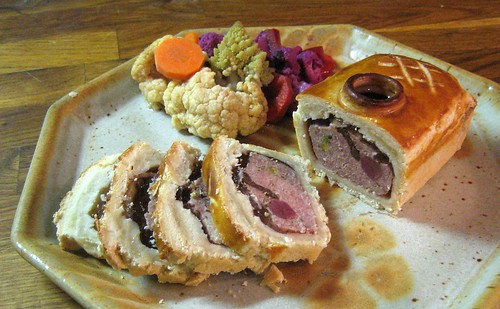
-
From last Easter. Smoked mustard-crusted sockeye salmon and eggs Mireille. Fresh sockeye salmon cured with 6%/3% sea salt/honey and mustard seeds for 48 hours, dried 24 hours with stone ground mustard seeds and lightly smoked in a file cabinet turned smoker. Salmon scraps (rather than tuna and anchovies) were blended into a cooked yolk filling with capers, pickles, mustard, sour cream and such, stuffed back into the whites and topped with a coin of the salmon.




The Rules of the Kitchen...
in Food Traditions & Culture
Posted
Any chef worth a damn uses metric units of weight in their recipes. Poor results are likely a matter of execution and unfamiliarity with terms/technique (ie,rissoler), theory and practice.